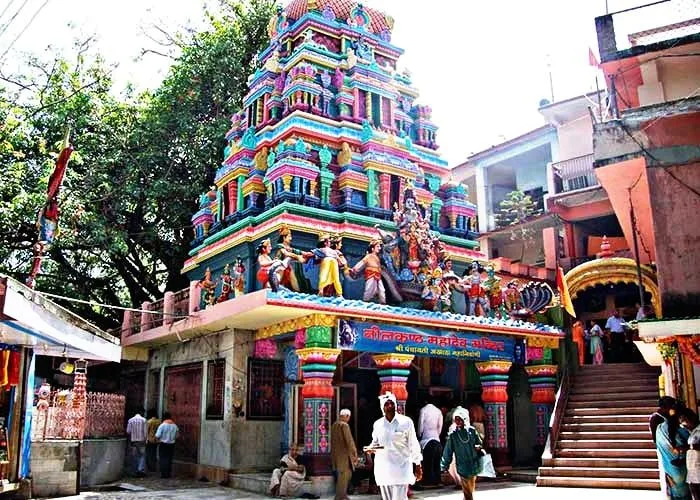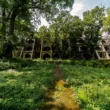Nestled amidst the lush greenery of the Garhwal Himalayas in Uttarakhand, India, the Neelkanth Mahadev Temple stands as a testament to ancient architectural prowess and spiritual significance. Perched at an altitude of 1330 meters above sea level, this sacred edifice is dedicated to Lord Shiva, revered as Neelkanth Mahadev, or the Blue-Throated God.
Historical Background
Legend of Neelkanth Mahadev
According to Hindu mythology, during the churning of the ocean (Samudra Manthan), a venomous substance emerged, threatening to engulf the universe. Lord Shiva, in his benevolence, consumed the poison to save humanity. As a result, his throat turned blue, earning him the appellation Neelkanth. The temple commemorates this divine deed of Lord Shiva.
Architectural Marvels
Design and Construction
The Neelkanth Mahadev Temple boasts intricate architecture, reflecting the rich cultural heritage of India. Built in the traditional Nagara style of temple architecture, it features ornate carvings, towering spires, and a sanctum sanctorum housing the sacred Shivalinga.
Significant Features
One of the most striking features of the temple is its backdrop of snow-capped peaks, offering a picturesque setting for spiritual contemplation. The temple complex also includes smaller shrines dedicated to various deities, enhancing its religious significance.
Spiritual Significance
Importance in Hindu Mythology
The temple holds immense significance in Hindu mythology, symbolizing the triumph of good over evil and the eternal presence of divine grace. Devotees flock to the temple seeking blessings, spiritual solace, and fulfillment of their wishes.
Pilgrimage Destination
Every year, thousands of pilgrims undertake arduous journeys to pay homage to Neelkanth Mahadev. The pilgrimage to the temple is considered a sacred endeavor, believed to cleanse the soul and bestow divine blessings upon the devotees.
Festivals and Celebrations
Maha Shivaratri
Maha Shivaratri, the Great Night of Lord Shiva, is celebrated with great fervor at the Neelkanth Mahadev Temple. Devotees observe fasts, perform rituals, and offer prayers to seek the blessings of Lord Shiva on this auspicious occasion.
Shravan Mas
The holy month of Shravan holds special significance for devotees of Lord Shiva. During this time, the temple resonates with the chanting of sacred hymns and the sound of bells as devotees throng to offer prayers and seek divine blessings.
Visitor Information
Location and Accessibility
The Neelkanth Mahadev Temple is located near Rishikesh in the Pauri Garhwal district of Uttarakhand, India. Situated amidst scenic surroundings, the temple is accessible via well-maintained roads and trekking trails.
Similar Article – Triveni Ghat
Entry Fees and Timings
There are no entry fees to visit the temple, and it remains open to devotees and tourists throughout the year. However, it is advisable to check the timings before planning a visit, especially during festivals and peak seasons.
Preservation Efforts
Conservation Initiatives
Efforts are underway to preserve and protect the architectural heritage of the Neelkanth Mahadev Temple. Conservation projects focus on restoring ancient structures, preventing environmental degradation, and promoting sustainable tourism practices.
Importance of Heritage Preservation
Preserving the Neelkanth Mahadev Temple is not just a matter of architectural conservation but also a testament to preserving the cultural identity and spiritual legacy of India. It serves as a reminder of our rich heritage and the need to safeguard it for future generations.
Nearby Attractions
Tourist Spots Around Neelkanth Mahadev Temple
The vicinity of the temple is replete with natural wonders and tourist attractions. From the pristine waters of the Ganges River to the tranquil forests of Rajaji National Park, visitors can explore a myriad of destinations offering serenity and adventure.
The Impact of Tourism
Socio-economic Influence
Tourism around the Neelkanth Mahadev Temple has contributed significantly to the socio-economic development of the region. It has generated employment opportunities, boosted local businesses, and enhanced infrastructure facilities.
Similar Article – Parmarth Niketan:
Environmental Concerns
However, the influx of tourists has also raised concerns about environmental conservation and sustainability. Efforts are being made to promote responsible tourism practices and minimize the ecological footprint around the temple premises.
Cultural Influence
Neelkanth Mahadev in Art and Literature
The awe-inspiring beauty and spiritual aura of the Neelkanth Mahadev Temple have inspired artists, poets, and writers across generations. Its depiction in art, literature, and folklore serves as a cultural motif, symbolizing devotion and transcendence.
Conclusion
The Neelkanth Mahadev Temple stands as a beacon of spirituality, heritage, and architectural grandeur. Its timeless allure continues to draw devotees and tourists from far and wide, offering them a glimpse into the rich tapestry of Indian culture and mythology.
FAQs
- Is photography allowed inside the temple premises?
- Yes, photography is permitted in designated areas of the temple complex. However, visitors are requested to respect the sanctity of the surroundings.
- Are there accommodation facilities available nearby?
- Yes, there are several accommodation options available in Rishikesh and surrounding areas to suit varying budgets and preferences.
- Can I visit the temple throughout the year?
- Yes, the Neelkanth Mahadev Temple remains open to visitors throughout the year, except during special occasions or unforeseen circumstances.
- Are there any trekking trails leading to the temple?
- Yes, there are trekking trails leading to the temple for adventure enthusiasts seeking a more immersive experience amidst nature.
- What should I wear while visiting the temple?
- It is advisable to wear modest and comfortable attire while visiting the temple, respecting the religious sentiments of devotees and maintaining decorum.









